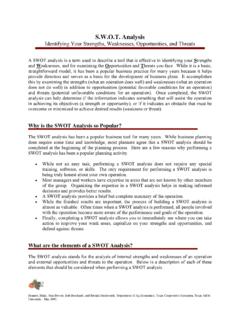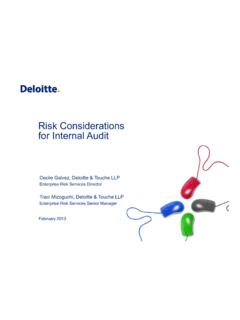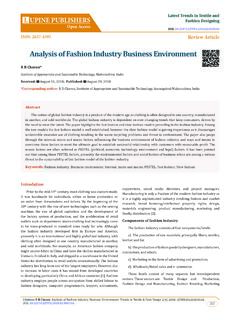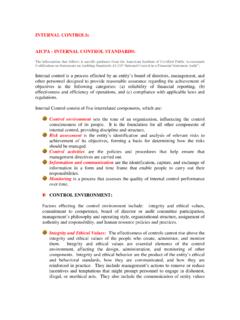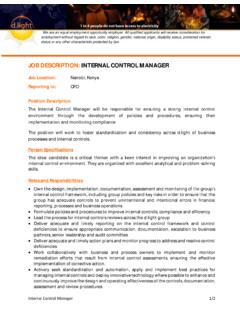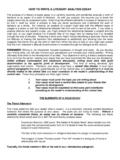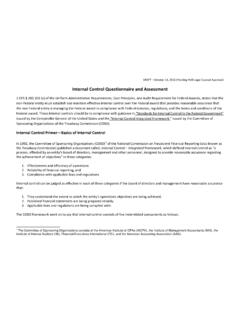Transcription of INTERNAL REVENUE CODE SECTION 280E: CREATING AN …
1 INTERNAL REVENUE CODE SECTION 280e : CREATING AN IMPOSSIBLE SITUATION FOR LEGITIMATE BUSINESSES What is SECTION 280e ? SECTION 280e of the INTERNAL REVENUE Code forbids businesses from deducting otherwise ordinary business expenses from gross income associated with the trafficking of Schedule I or II substances, as defined by the Controlled Substances Act. The IRS has subsequently applied SECTION 280e to state-legal cannabis businesses, since cannabis is still a Schedule I substance. A throwback from the Reagan Administration, SECTION 280e originated from a 1981 court case in which a convicted cocaine trafficker asserted his right under federal tax law to deduct ordinary business expenses. In 1982, Congress created 280e to prevent other drug dealers from following suit.
2 It states that no deductions should be allowed on any amount in carrying on any trade or business if such trade or business consists of trafficking in controlled substances. With 23 states and the District of Columbia now allowing some form of legal marijuana, 280e is applied to state-regulated cannabis businesses more often than it is to the types of illegal drug dealers that the provision was intended to penalize. How does SECTION 280e hurt state-legal cannabis businesses? Federal income taxes are based on a fairly simple formula: start with gross income, subtract business expenses to calculate taxable income, and then pay taxes on this amount. Owners of regular businesses often derive profits from these business deductions.
3 Cannabis businesses, however, pay taxes on gross income. These businesses often pay tax rates that are 70% or higher. As John Davis, owner of the Northwest Patient Resource Center in Seattle, WA states, I m taxed on nearly double the amount that my business actually makes. Below is a simplified model that illustrates the tax structure for cannabis businesses compared to a normal businesses. In this scenario, the normal business s taxable income is $150,000, while the cannabis business is taxed on $350,000, despite having the same costs and expenses. Non-Cannabis Business Cannabis Business Gross REVENUE $1,000,000 $1,000,000 Cost of Goods Sold $650,000 $650,000 Gross Income $350,000 $350,000 Deductible Business Expenses $200,000 $0 Taxable Income $150,000 $350,000 Tax (30%) $45,000 $105,000 Effective Tax Rate 30% 70% I m taxed on nearly double the amount that my business actually makes.
4 John Davis, Northwest Patient Resource Center! The taxation problem facing cannabis businesses just got worse. In January 2015, the INTERNAL REVENUE Service issued an INTERNAL memorandum that opined on how state-legal cannabis businesses should compute federal income taxes. Drafted by the IRS Chief Counsel, the memo rejects many of the tax deductions that these businesses have traditionally made. The memo challenges tax strategies that allow these businesses to stay afloat, and imposes a strict interpretation of SECTION 280e of the INTERNAL REVENUE Code. Without even the meager deductions state-legal cannabis businesses were previously allowed to take, these businesses face a bleak financial future. This deeply affects their ability to reinvest profits back into their local communities and fulfill the will of state voters, legislatures, and regulatory bodies that have mandated that cannabis be dispensed through legal storefronts.
5 Jim Marty, a CPA with Colorado s Bridge West CPAs, says that many marijuana businesses are going to struggle under the new rules. There are a lot of businesses that are going to get absolutely creamed, he says. What types of business expenses are scrutinized under 280e ? Employee salaries Utility costs such as electricity, internet and telephone service Health insurance premiums Marketing and advertising costs Repairs and maintenance Rental fees for facilities Routine repair and maintenance Payments to contractors State-legal cannabis businesses are allowed to deduct the Cost of Goods Sold (COGS) on their taxes. Also, since 2007, cannabis businesses have made deductions on their non-cannabis business activities.
6 Most importantly, however, cannabis businesses have also followed guidance from SECTION 263A of the IRC, which allows businesses to capitalize on indirect costs such as administrative and inventory costs, as well as the amount paid in state excise taxes and deduct them under COGS. Depending on the business, these indirect costs can be sizable. The strategy of including these costs in COGS is oftentimes what allows cannabis businesses to collect meager profits. What deductions are now likely to be challenged? General and administrative costs (bookkeeping, legal expenses, technology costs) State excise taxes Storage of cannabis Purchasing cannabis Depreciation of cannabis There are a lot of businesses that are going to get absolutely creamed.
7 Jim Marty, Bridge West CPAs How did these deductions benefit cannabis businesses? Attached below are three documents that illustrate how 280e has applied to typical cannabis businesses both before and after the tightening of IRS rules. Figure 1 is a 1065 tax filing from 2013 from a medical cannabis business in Denver, Colorado. Gross receipts totaled $776,772, and thanks to some strong work by a CPA, the business was able to deduct $435,819 in Cost of Goods Sold, leaving a gross income of $340,953. The business had an additional $153,806 in deductions that any other business would be able to take, but were disallowed under 280e . Since the business was allowed deductions on Cost of Goods Sold, it paid taxes on $340,953 instead of on $776,772.
8 Its effective tax rate was still 55% of its final earnings, but the business owner was able to invest the remaining cash back into the business. Without these deductions, what does a final tax bill look like for a state-authorized cannabis business? Figure 2 is a 1065 tax filing from 2014 from a medical cannabis dispensary in Seattle, Washington. The business followed the new, even stricter 280e rules in its filing. As the documents show, gross income from this business totaled $154,469 for 2014, and the business had $101,100 in expenses. If this business were a regular business, it would be taxed on its earnings, which were $53,369. In order to comply with 280e , however, the business was unable to take these deductions, and instead it paid taxes on $154,469.
9 The business tax payment totaled $46,340, which equates to 87% of its true earnings. The business owner had only $7,029 to either invest back into his business or keep as profit. What s the worst-case scenario for a business under 280e ? Figure 3 is a 1065 and Statement of Activities and Changes In Net Assets from a medical marijuana dispensary in Arizona. The business produced $876,420 in gross receipts and was permitted to deduct $319,386 in Cost of Goods Sold, but could take no deductions for its other expenses. The business, thus, was taxed on its gross income, which was $557,034. Like many startup businesses, however, the dispensary had significant first-year expenses, which totaled $867,863. These operating expenses were non-deductible under 280e .
10 So while the business actually lost a total $310,829 for the year, its tax bill was still $189,781. Despite bringing in $876,420, the business ended up more than half a million dollars in the red. Mitch Woolheiser, owner of Northern Lights Cannabis in Edgewater, Colorado, said he s hoarding cash in preparation for his tax payment. I can t give my employees raises. I can t put money back into my business. Instead I ve been hoarding cash in anticipation of what the IRS is going to take, Woolheiser says. How many state economies are affected by 280e ? SECTION 280e affects all businesses that engage in the cultivation, sale, or processing of the cannabis plant. This includes cultivators, medical dispensaries, marijuana retail stores, and infused product manufacturers, as well as concentrates and cannabis oil manufacturers.

